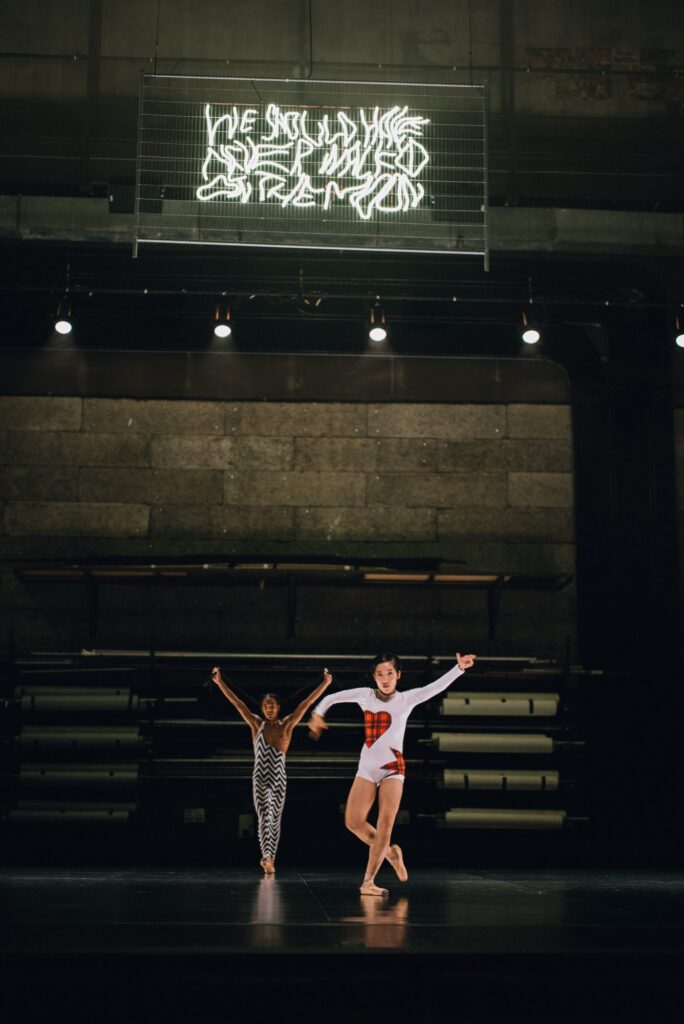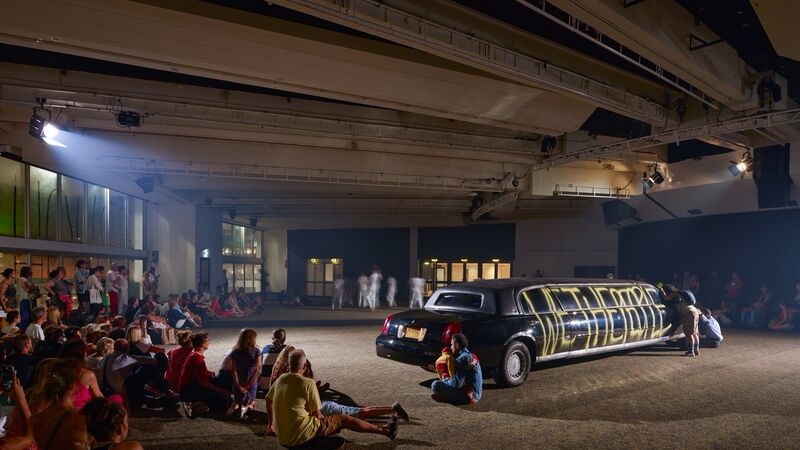Words by Bengi-Sue Sirin.
‘We should have never walked on the moon’ is a comment that Hollywood star Gene Kelly is reported to have made to astronaut Buzz Aldrin. WE SHOULD HAVE NEVER WALKED ON THE MOON by Rambert and (LA)HORDE explores the role of the body in a post-internet age of endless information and communication, dominated by mainstream US culture, and the relationship between dance and cinema.
Did Gene say we should never have walked on the moon because he foresaw a spiral of destruction spinning from what seemed like progress? Or because it’s a territory that humans simply shouldn’t venture into? Or maybe he was thinking about the Icarus myth…You could interpret it many ways; and that is precisely what you’ll be doing should you attend this three hour dance odyssey at the Southbank Centre, where the entire building has been transformed into a festival of dance set in a sort of post-apocalyptic futurescape.
You’ll enter through more security than usual for a theatre show. They’ll give you a map and possibly escort you to places. Then you’ll be free to roam anywhere you choose, only encountering the audience, dancers and ushers the whole time, the world shut out for three hours of immersion. Sometimes you won’t even be able to tell who is who; you’ll see dancers nonchalantly exit the piece and blend into the crowd; people in very distinctive outfits with very distinctive walks passing by one minute and the next, they’re in the dance. I thought my show buddy Angel would fit right into the car pieces, and even questioned his participation for a second! You’ll feel a mixture of excitement at all the possibilities – multiple performances at once, 24 to choose from – and a slight dismay at all the things you’ll miss, a feeling very akin to festivalgoing and totally at odds with the standard ticket-seat-theatre-interval-applause format of a dance show.
Angel and I didn’t manage to see everything. I’m not sure anyone could! But in our time there we crammed a lot in, and left several of these pieces feeling something. I think the first vignette that really impacted us was the limousine phrase, in its gorgeously striking setting of one of the Southbank’s many outdoor terrace areas, overlooking the sunset and the river.
Against this backdrop was a smashed up black limo, it and its surroundings covered in graffiti reading things like TOMORROW IS CANCELLED and WE THE PEOPLE and the Audre Lorde quotation the master’s tools will not dismantle the master’s house. Dancers of all ages were driving factory vehicles around listlessly. Some lay on the limo. Some spray painted. Protest footage played on a huge screen nearby. Participants dipped in and out, seemingly coming from other pieces when they had a minute between runs. It was a capsule of the listlessness and inertia that can come from this grim and oftentimes austere chapter we are living through, that Ballardian what now despondency. Very powerful.
There was more in the realm of the bleak, upstairs at the very top of the Royal Festival Hall. A man and a woman performed a duet in an enclosed outdoor space where we the audience were indoors, watching them like animals in a zoo. What began as playful and flirtatious descended into violence, abuse, disparity between the two. And as the female dancer stripped right down to her underwear, suddenly being on the inside looking out felt voyeuristic, nasty and unhelpful. It was a gut punch of a piece; not all kitchen sink style but with some moments of tenderness too. Leaving the world they created before they had finished felt a bit rude because of how much vulnerability was on show. And yet, there was so much to see, so much choice, almost endless! We should never have walked on the moon because when do we know when to stop….?
My favourite piece took place in the Royal Festival Hall itself, a piece that took the evening’s audience/participator dichotomy even further. We were led not to the seating auditorium of the Hall but to the stage, where we sat or stood as we wished. On a gigantic screen towards the back of the theatre there was footage of music festival hedonism, building up into shots of crowds and drunkenness. I was pretty transfixed – what a bizarre experience, to be and audience to an audience sat on the platform that an audience normally looks up at!
Then – the smash of chords on a gigantic organ – coming from behind us, where the stage backdrop would be. A piano player with her back to us and two individuals either side of her. Grisaille shades of lighting made for a strangely silvery scene. The two dancers slowly made their way down the steps of the platform; the steps of the stage, and up to the middle of probably around Row S, illumintated by this eerie lighting and the lake scene projected onto the screen now behind them. They moved in ways evocative of a baptism, taking turns to dip the other into holy submission. Then baptisms began to play on the screen too. It was slow, calm, the wholesomeness of a detox day after losing your marbles at a festival. Mesmerising. Just grey; unusual staging in an evocative venue; simple movements; and an organ. A perfect example of how the synergy of elements, no matter how unembellished they may seem in their individual forms, can say so much.
I have another example of this too. A sort of easter egg within the show, that you spotted every now and again. I mentioned before that part of WE SHOULD HAVE NEVER WALKED ON THE MOON’s charm is the total blurring of lines between audience and dancer. But there was one character who totally unmistakably not part of the crowd; a man with a rig of 40 mobile phones attached to him, a sort of mass-gaming, multiple selfie-taking, endlessly-googling figure that walked around with the uncanniness of a stick insect and the insularity of a mollusc. Weird description because it was a very weird sight – in a captivating way!

I think Angel and I caught sight of him twice, each time it was a hey there he is!! sort of interaction. In my mind he seemed very definitely a visual metaphor for the idea of ‘data roaming’ – if data could literally roam, it would look like him. But don’t quote me on that! As playful as it was, there was an undercurrent of darkness too; is this what we’ve become? The data roamer would have fitted right into the worlds of J. G. Ballard, of China Mieville, and of the triffid-run future that we are probably all heading into anyway.
But! WE SHOULD HAVE NEVER WALKED ON THE MOON wasn’t a wholly bleak affair. There were moments of beauty within the dystopia, the strongest of which for me was Hop(e)storm. Performed in the Queen Elizabeth Hall, Hop(e)storm looked like one of the most joyful pieces to dance that I’ve seen in a long time!
It started with dancers butting up against each other like stags, then melted into a joyful celebration that mingled elements of Irish dance, two-stepping, street, contemporary, lindy hop and how you dance when you’re out at the clurb. SO GOOD!! Shout out to the dancer with the blonde mullet because Angel and I couldn’t take our eyes off him! Amongst the dystopia and the despair it truly was a storm of hope and it was tempting to sit and watch it again on its later run. I kind of wish I did to be honest. Make sure you catch that one!!
WE SHOULD HAVE NEVER WALKED ON THE MOON is its own universe, kind of overwhelming in scale but also a rare opportunity to take in dance on your own terms. A variety of post-apocalyptic, dsytopic, amusing, moving, three dimensional, flat, depressing and hopeful vignettes; a peering into a possible future of life after walking on the moon. Was Gene Kelly right? Perhaps some progress opens cans of worms that we wish we could stuff back in. But had we never walked on the moon, there’s a lot of stuff that we wouldn’t have too, including this show in its epic, moon-sized scale. Yes, not everything we saw had the punch of Hop(e)storm and the baptism piece and the limosine tableau. But it’s like that saying – ‘shoot for the moon, and if you miss you’ll still be among the stars.’ There were stars aplenty at WE SHOULD HAVE NEVER WALKED ON THE MOON!
Runs until Saturday 6 September, book here. Header image by François Deladerriere.
